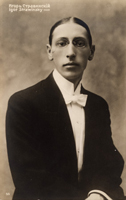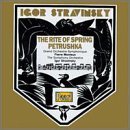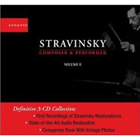
Stravinsky on the Podium and at the Piano, Part 1
I was a senior in high school when Igor Stravinsky died in 1971. The newspaper headlines were large enough to commemorate a major political figure, movie star, or sports figure. Stravinsky is to me a living composer, someone whose life intersected with my own, chronologically at least.
The Columbia Record Club, my lifeline to the musical world in those days, had been bringing out the Stravinsky-led recordings throughout the 1960s, and by the last few years of the decade I was collecting them assiduously.
What an incredible gift they are -- the recorded interpretations of a great and influential composer. Maybe they aren't always the best recorded performances (they seldom are, in fact), but they carry a weight of undeniable authority. Fortunately for us, Stravinsky's compositional career coincided with the growth of the recording industry, making him one of the best-ever documented composers.
He wasn't a first-rate conductor, to be sure, but that's nitpicking.
 I'd like to look at the Stravinsky recordings over the course of several articles; he left us renditions of just about his entire output.
I'd like to look at the Stravinsky recordings over the course of several articles; he left us renditions of just about his entire output.
Sometimes Stravinsky recorded his own works more than once -- four times for The Firebird (either complete or as a suite), and three times for Le Sacre du Printemps, Apollo, Fireworks, Jeu des cartes, Pulcinella (complete or suite), and the Symphony in Three Movements. (There are even more renditions amongst preserved radio broadcasts and telecasts -- check out YouTube.)
From his pre-Paris works such as the Symphony in E-flat, to his final The Owl and the Pussycat for voice and piano, Stravinsky put it all down on wax, vinyl, and magnetic tape.
Let's begin with the pre-WWII recordings. They're getting harder and harder to track down, alas, although they've all been digitized and transferred to CD. I'll provide links wherever I can, but I can't promise each and every one.
Although Stravinsky played some of his Cinq doigts piano pieces for Brunswick in the mid-1920s (acoustic recordings which went unpublished), the first significant recordings come from 1928-1929.
 These are The Firebird and The Rite of Spring, each recorded with the Orchestre des Concerts Straram, a high-class Paris group specializing in modern music, founded by the conductor Walther Straram in 1926. (Straram himself conducted the premiere of Ravel's Bolero.) Due to legal issues, the orchestra was not named explicitly on the recording, credited instead as the suspiciously-neutral Orchestre Symphonique.
These are The Firebird and The Rite of Spring, each recorded with the Orchestre des Concerts Straram, a high-class Paris group specializing in modern music, founded by the conductor Walther Straram in 1926. (Straram himself conducted the premiere of Ravel's Bolero.) Due to legal issues, the orchestra was not named explicitly on the recording, credited instead as the suspiciously-neutral Orchestre Symphonique.
The Firebird was recorded at the Columbia studios in the Théâtre des Champs-Elysées on November 8-10, 1928. The release was a major event; French Columbia threw a big gala celebrating the recording, including a bit of silent film of Stravinsky conducting -- which I'm including here:
The fundamental romanticism of the Firebird score brought out a lovely performance from the French musicians, who were captured with exceptionally good audio quality for the era. Oh, there are blips and bloops, particularly from the brass, but it's clear that the score was well within the technical grasp of both orchestra and conductor.
The same cannot be said of the Rite of Spring, recorded in the same venue on May 7-10, 1929. It's a fascinating window into the sound of a French orchestra playing the score a bare 16 years after the premiere, but technical insufficiency on the part of orchestra and conductor both are painfully obvious. The ensemble and intonation problems notwithstanding, there are fascinating moments to be heard throughout. (Incidentally, Stravinsky takes the score's half note = 50 tempo at Dances of the Adolescents; it sounds noticeably slow compared to his later recordings which run closer to 56.)
The Straram orchestra was also on hand for the 1931 Symphony of Psalms, recorded with the Russian-emigré Alexis Vlassov Choir a mere two months after the work's world premiere, and a week before the Parisian debut. Unlike many later performances -- including Stravinsky's 1963 Toronto version -- which aim for vocal austerity, the chorus is here warm, robust, and full-bodied; particularly impressive are the luscious vocal portamenti (i.e., slides) in the final movement. Stravinsky's biographer Stephen Walsh has this to say about it:
As for the recording of the symphony, it was the most important Stravinsky made in these early years, being uninhibited by technical limitations (unlike his early recordings of the ballets) and so supporting his claim that a composer's recording of his own work is an authoritative document of its performance style. Modern Western taste would perhaps now reject the swooping portamenti of the Alexis Vlassov Choir. But this is to some extent a measure of how far Stravinsky's neoclassical works have drifted away, in the modern perception, from their Russian originals...several aspects of the works' harmony and rhythm hark back almost nostalgically to a time when he was composing Russian texts and Russian scenarios.
We may also thank the Straram orchestra for Stravinsky's 1930 piano soloist gig in the Capriccio for Piano and Orchestra, one of the two piano & orchestra works of his neo-classical period. In this recording, Stravinsky's longterm collaborator Ernest Ansermet helmed the orchestra. Given that the venue was the Théâtre des Champs-Elysées (the site of the premiere of the Rite of Spring), this is one of those performances that simply drips authenticity, as if Ferdinand David had recorded the Mendelssohn Violin Concerto with Felix Himself conducting the Leipzig Gewandhaus orchestra. (And no, such a recording doesn't exist.)
 Note: many of the following recordings were made available by Andante Records' "Igor Stravinsky: Composer & Conductor, Volume 1". This was, alas, a limited edition and is now out of print. The ISBN is 0-9712764-8-X, should you wish to hunt down a copy.
Note: many of the following recordings were made available by Andante Records' "Igor Stravinsky: Composer & Conductor, Volume 1". This was, alas, a limited edition and is now out of print. The ISBN is 0-9712764-8-X, should you wish to hunt down a copy.
Two more volumes are easily available, however: Here's Volume 2, and here's Volume 3. To date, the Andante sets remain the best sources for early Stravinsky recordings.
Update: ArkivMusic.com, the Nordstrom of online CD stores, has brought out the EMI compilation of early Stravinsky recordings as an ArkivCD reprint. Many of the performances mentioned below can be found in this set, if you don't want to try tracking down the Andante Records album, definitely a rarity.
The Neapolitan-inspired ballet Pulcinella has always been a big favorite (for one thing, it's full of great tunes courtesy of its late-Baroque originals). Stravinsky gave us some excerpts (not quite the Pulcinella Suite), recorded partially in 1928 then completed in 1932, with an uncredited "Instrumental Ensemble" -- probably musicians drawn from the Straram orchestra.
This recording, like several others from the early 1930s, was made in Paris's Studio Albert, a venue apparently lacking soundproofing; one anecdote concerns bribing a neighbor to remove his barking pooch from the neighborhood during the recording sessions.
A messy but entertaining L'Histoire du Soldat comes from the same year, same studio.
Also from the Studio Albert in 1932 comes a superb all-French Octet, still one of the better renditions out there of this critically influential work, followed in 1934 by Stravinsky's own piano performance of the Serenade in A, a piece written specifically with recording in mind (each of the four movements clocks in just under three minutes, that being the average length of a 78 rpm record side at the time.)
During that same July of 1934 the yapping canine was again banished from the vicinity to give us two pieces titled Ragtime -- one for solo piano (also called the Piano-Rag Music), and the other for 11 instruments, each requiring just one side of a 78 rpm disc. Stravinsky played the solo piece a bit cautiously (probably to avoid problems with the equipment, notoriously finicky about sudden dynamic changes), and a fine group of players (including Aladar Racz on cymbalon) romped through Ragtime for 11 Instruments, surely one of Stravinsky's kookiest inspirations.
Across the Channel Stravinsky conducted a Les noces, theoretically in English, in 1934 at Abbey Road Studios. The singers -- Kate Winter, Linda Seymour, Parry Jones, and Roy Henderson -- and choir together suffer from such glutinously operatic diction as to render the text almost completely indecipherable, all vowels and no consonants. The messy diction is matched by equally slapdash ensemble. The responsibility here almost certainly rests entirely with Stravinsky; Les noces requires a virtuoso conductor. (I played it once under the baton of a most distinctly non-virtuoso conductor, and I can attest to the gory mosh that ensued even after a gawdawful number of rehearsals.)
 Stravinsky's collaboration with American violinist Samuel Dushkin resulted in a number of memorable works, none more so than the Violin Concerto, recorded by Dushkin in 1935 at the Salle Pleyel with Stravinsky conducting the Lamoureux Orchestra. The two also gave us a thoroughly authoritative rendition of the Duo Concertante in 1933, and galloped delightfully through a set of arrangements of various Stravinsky works in the same year.
Stravinsky's collaboration with American violinist Samuel Dushkin resulted in a number of memorable works, none more so than the Violin Concerto, recorded by Dushkin in 1935 at the Salle Pleyel with Stravinsky conducting the Lamoureux Orchestra. The two also gave us a thoroughly authoritative rendition of the Duo Concertante in 1933, and galloped delightfully through a set of arrangements of various Stravinsky works in the same year.
Another favored collaborator: Stravinsky's own son, Soulima. The Concerto for Two Pianos, one of the neglected Stravinsky masterpieces, was put down in a gloriously flinty performance by father and son in Paris (Studio de la Grand Armée) in February of 1938.
Finally, a great orchestra: the Berlin Philharmonic, joining Stravinsky in giving us a 1938 Jeu de cartes, only one year after the work's premiere.
A major upheaval was under way in Stravinsky's life, and his next series of recordings would be made across the Atlantic, in his newly adopted country, the United States.
In the next installment, I'll be covering Stravinsky's American-inspired works of the 1940s and 1950s.
